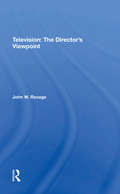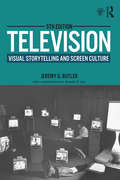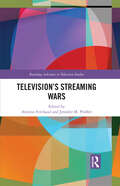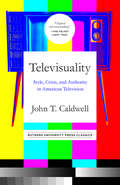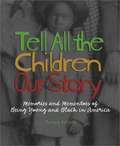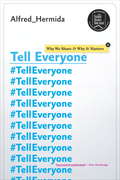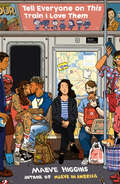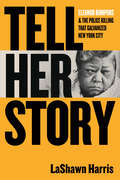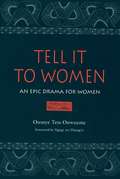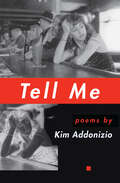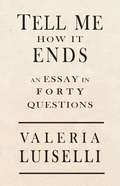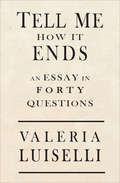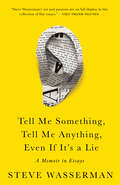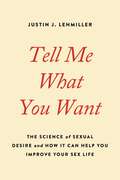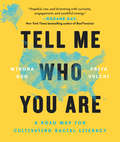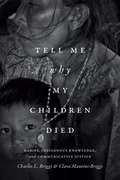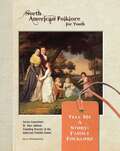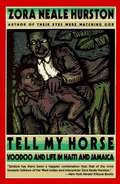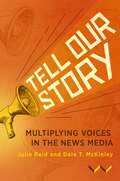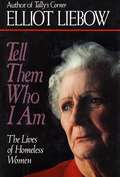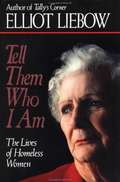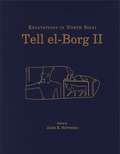- Table View
- List View
Television: The Director's Viewpoint
by John W. Ravage Jack RavageTelevision directors remain an enigma to most students of the mass media; traditionally, their function has been little understood by scholars and the viewing public. In this book, John Ravage studies the role of the director in the producer-dominated medium of commercial television. Built around lengthy interviews with twelve of the leading directors of commercial programs—representing all the genres of "prime time"—the book analyzes the major issues facing television, its past, present, and portents for the future, and the audience that watches it.
Television: Visual Storytelling and Screen Culture (Routledge Communication Ser.)
by Jeremy G. ButlerFor over two decades, Television has served as the foremost guide to television studies, offering readers an in-depth understanding of how television programs and commercials are made and how they function as producers of meaning. Author Jeremy G. Butler shows the ways in which camera style, lighting, set design, editing, and sound combine to produce meanings that viewers take away from their television experience. Highlights of the fifth edition include: An entirely new chapter by Amanda D. Lotz on television in the contemporary digital media environment. Discussions integrated throughout on the latest developments in screen culture during the on-demand era—including the impact of binge-watching and the proliferation of screens (smartphones, tablets, computer monitors, etc.). Updates on the effects of new digital technologies on TV style.
Television’s Streaming Wars (Routledge Advances in Television Studies)
by Arienne Ferchaud Jennifer M. ProffittThis volume addresses contemporary debates and trends regarding the production and distribution, content, and audience engagement with the television streaming industry. The book interrogates the economics and structure of the industry, questions the types and diversity of content perpetuated on streaming services, and addresses how audiences engage with content from US and global perspectives and within various research paradigms. Chapters address television streaming wars, including the debates and trends in terms of its production and competition, diversity and growth of programming, and audience consumption, focusing on multiple platforms, content, and users. This timely and creative volume will interest students and scholars working in television studies, media industry studies, popular culture studies, audience studies, media psychology, critical cultural studies and media economics.
Televisuality: Style, Crisis, and Authority in American Television (Communications, Media, and Culture Series)
by John T CaldwellAlthough the "decline" of network television in the face of cable programming was an institutional crisis of television history, John Caldwell's classic volume Televisuality reveals that this decline spawned a flurry of new production initiatives to reassert network authority. Television in the 1980s hyped an extensive array of exhibitionist practices to raise the prime-time marquee above the multi-channel flow. Televisuality demonstrates the cultural logic of stylistic exhibitionism in everything from prestige series (Northern Exposure) and "loss-leader" event-status programming (War and Remembrance) to lower "trash" and "tabloid" forms (Pee-Wee's Playhouse and reality TV). Caldwell shows how "import-auteurs" like Oliver Stone and David Lynch were stylized for prime time as videographics packaged and tamed crisis news coverage. By drawing on production experience and critical and cultural analysis, and by tying technologies to aesthetics and ideology, Televisuality is a powerful call for desegregation of theory and practice in media scholarship and an end to the willful blindness of "high theory."
Tell All The Children Our Story: Memories and Mementos of Being Young and Black in America
by Tonya BoldenIn a warm, personal voice, Tonya Bolden explores what it has meant to be young and black in America. From the first recorded birth of a black child in Jamestown, through the Revolution, the Civil War, Reconstruction, and the fight for civil rights, right on up to our own time, Bolden brings to light how black children have worked and played, suffered and rejoiced.
Tell Everyone
by Alfred HermidaIdeas and stories that would once only reach a handful of people can now reverberate across the world, amplifying the power of individuals, informing our choices, and changing how we receive and react to the news. Tell Everyone explores and explains a more open, vibrant and diverse media Every day more than 500 million messages are sent on Twitter, 800 million people share four billion stories, links, photographs and videos on Facebook. Every minute, 100 hours of video is uploaded to YouTube. And the flow is ever-increasing. In this new era of media saturation, what do we mean by "the news"? Is "the most trusted name in news" today a veteran anchor on television or an undergraduate tweeting from Tahrir Square in Cairo? The day before yesterday, news and information was scarce, coming from a few newspapers or broadcasters. Now, not only are we able to connect and collaborate to create our own media, but for the first time have access to a global audience. Together we can help to bring down governments or chasten international corporations. We can hasten the spread of gossip, rumour and lies. We can market our products more widely and efficiently than ever--if we take the trouble to discover why people share and to whom. In this groundbreaking work, online news pioneer and social media maven Alfred Hermida examines how our ability to create and share news is shaping the information we receive and depend on to make informed decisions, from choosing politicians to doing business. Drawing on historical examples, real-world experiences and leading research, he equips us with the knowledge and insight to navigate successfully the social streams of information that shape how we view the world.--a more open, vibrant and diverse media.
Tell Everyone on This Train I Love Them
by Maeve HigginsDeeply funny, moving, and urgent writing about a country that can feel broken into pieces and the light that shines through the cracks, from Irish comedian Maeve Higgins, author of Maeve in America. As an eternally curious outsider, Maeve Higgins can see that the United States is still an experiment. Some parts work well and others really don&’t, but that doesn't stop her from loving the place and the people that make it. With piercing political commentary in a sweet and salty tone, these essays unearth answers to the questions we all have about this country we call home; the beauty of it all and the dark parts too. Maeve attends the 2020 Border Security Expo to better understand the future of our borders, and finds herself at The Alamo surrounded by queso and homemade rifles. A chance encounter with a statue of a teenage horseback rider causes her to interrogate the purpose of monuments, this sends her hurtling through the past, connecting Ireland&’s revolutionary history with the struggles of Black Americans today. And after mistaking edibles for innocent candies, Maeve gets way too high at Paper Source. Most of all, Maeve wants to leave this country and this planet better than she found it. That may well be impossible, but it certainly means showing love. Lots of it, even when it's difficult to do so. Threaded through these pieces is love for strangers, love for friends who show up right on time, love for trees, love for Tom Hardy, love for those with differing opinions, love for the glamorous older women of Brighton Beach with tattooed eyeliner and gold jewelry, love for everybody on this train.
Tell Her Story: Eleanor Bumpurs & the Police Killing That Galvanized New York City
by LaShawn HarrisThe life and 1984 murder of a beloved Black grandmother that changed community activism forever—and sparked the ongoing movement against racist policing and brutality #SayHerName: The story of Eleanor Bumpurs, told for the first time by decorated historian and Bumpurs's former neighbor LaShawn HarrisOn October 29, 1984, 66-year-old beloved Black disabled grandmother Eleanor Bumpurs was murdered in her own home. A public housing tenant 4 months behind on rent, Ms. Bumpurs was facing eviction when white NYPD officer Stephen Sullivan shot her twice with a 12-gauge shotgun. LaShawn Harris, 10 years old at the time, felt the aftershocks of the tragedy in her community well beyond the four walls of her home across the street.Now an award-winning historian, Harris uses eyewitness accounts, legal documents, civil rights pamphlets, and more to look through the lens of her childhood neighbor's life and death. She renders in a new light the history of anti-Black police violence and of the watershed anti-policing movement Eleanor Bumpurs's murder birthed.So many Black women's lives have been stolen since—Deborah Danner, Sandra Bland, Breonna Taylor, Sonya Massey—and still more are on the line. This deeply researched, intimate portrait of Eleanor Bumpurs's life and legacy highlights how one Black grandmother&’s brutal police murder galvanized an entire city. It also shows how possible and critical it is to stand together against racist policing now.
Tell It to Women: An Epic Drama for Women
by Ngugi Wa Thiong’o Osonye Tess OnwuemeUsing the magic of movement, dance, and drama, and the devices of humor and metaphor, Osonye Tess Onwueme has created a post-feminist epic drama that transcends current feminist theories. An ideologically and politically powerful work, Tell It to Women offers a critical discourse on the western feminist movement from an African traditional perspective, focusing attention on the often silenced issues of intra-gender politics and class inequities.
Tell It to the Mafia
by Wyn Hope Joe Donato"Your Honor, we, the people of the State of California intend to ask the death penalty in the trial of Joseph Daniel Donato, accused of murder in the first degree." This is the story of how Joe Donato became a born-again Christian.
Tell Me
by Kim AddonizioIn this new collection by the author of the award-winning The Philosopher's Club, Kim Addonizio takes the grist of the world and transforms it into poems of transcendent beauty. The dual themes of love and loss are pervasive in Addonizio's poems, made poignant by her keen eye and wise observations.
Tell Me (American Poets Continuum)
by Kim AddonizioIn this new collection by the author of the award-winning The Philosopher's Club, Kim Addonizio takes the grist of the world and transforms it into poems of transcendent beauty. The dual themes of love and loss are pervasive in Addonizio's poems, made poignant by her keen eye and wise observations.
Tell Me How It Ends: An Essay In 40 Questions
by Valeria LuiselliA damning confrontation between the American dream and the reality of undocumented children seeking a new life in the US.
Tell Me How It Ends: An Essay in 40 Questions (The Golden Greek)
by Valeria LuiselliAmerican Book Award Winner: A &“moving, intimate&” account of serving as a translator for undocumented children facing deportation (The New York Times Book Review). Nonfiction Finalist for the Kirkus PrizeFinalist for National Book Critics Circle Award for Criticism Structured around the forty questions volunteer worker Valeria Luiselli translates from a court system form and asks undocumented Latin American children facing deportation, Tell Me How It Ends humanizes these young migrants and highlights the contradiction between the idea of America as a fiction for immigrants and the reality of racism and fear—here and back home. &“Luiselli&’s prose is always lush and astute, but this long essay, which borrows its framework from questions on the cold, bureaucratic work sheets with which she became so familiar (for example, &‘Did anything happen on your trip to the U.S. that scared or hurt you?&’), is teeming with urgency…In this slim volume about the spectacular failure of the American Dream, she tells the stories of the unnamed children she&’s encountered and their fears and desires, as well as her own family&’s immigration story.&” —Vulture &“Worthy of inclusion in a great American (and international) canon of writing about migration.&” –Texas Observer &“A powerful indictment of American immigration policy, [Tell Me How It Ends] examines a system that has failed child refugees in particular.&” —Financial Times &“Masterfully blends journalism, auto/biography, and political history into a compelling and cohesive narrative. . . . Luiselli uses the personal to get political but smartly sidesteps identity politics to focus on policy instead.&”—The Rumpus
Tell Me Something, Tell Me Anything, Even If It's a Lie: A Memoir in Essays
by Steve WassermanAn exhilarating journey through the world of books, featuring personal reflections on Susan Sontag, Huey Newton, Barbra Streisand, W. G. Sebald, and Christopher Hitchens."A troublemaker of the good kind since his youth, Wasserman continues to inspire with his vigorous dedication to the life of the mind, exhibited with clarity and grace in this book." —Viet Thanh NguyenBorn on the West Coast, the son of Bronx-born parents, Steve Wasserman is a generalist and public intellectual but is perhaps less well known as a cultural essayist and social critic of the first rank. In thirty splendid essays, originally published in such diverse publications as The New Republic and The Nation, The American Conservative and The Progressive, The Village Voice and The Economist, Wasserman delivers a riveting account of the awakening of an empathetic sensibility and a lively mind. Taken together, they reveal the depth and breadth of his enthusiasms and range over politics, literature, and the tumults of a world in upheaval.These essays include the remarkable tale of a bookstore owner who wouldn't let him buy the books he wanted, to his brave against-the-grain take on the Black Panthers, to his shrewd assessment of the fast-changing world of publishing. Here is, as Joyce Carol Oates notes, "arguably the very best concise history of Cuba and the legendary Fidel Castro; beautifully composed eulogies for two close friends, Susan Sontag and Christopher Hitchens; sharply perceptive commentary on Daniel Ellsberg; a thrillingly candid interview with W. G. Sebald."
Tell Me What You Want: The Science of Sexual Desire and How It Can Help You Improve Your Sex Life
by Justin J. LehmillerA leading expert on human sexuality and author of the blog Sex and Psychology offers an unprecedented look at sexual fantasy based on the most comprehensive, scientific survey ever undertaken. What do Americans really want when it comes to sex? And is it possible for us to get what we want? Justin J. Lehmiller, one of the country's leading experts on human sexuality and author of the popular blog Sex and Psychology, has made it his career's ambition to answer these questions. He recently concluded the largest and most comprehensive scientific survey of Americans' sexual fantasies ever undertaken, a monumental two-year study involving more than 4,000 Americans from all walks of life, answering questions of unusual scope. Based on this study, Tell Me What You Want offers an unprecedented look into our fantasy worlds and what they reveal about us. It helps readers to better understand their own sexual desires and how to attain them within their relationships, but also to appreciate why the desires of their partners may be so incredibly different. If we only better understood the incredible diversity of human sexual desire and why this diversity exists in the first place, we would experience less distress, anxiety, and shame about our own sexual fantasies and better understand why our partners often have sexual proclivities that are so different from our own. Ultimately, this book will help readers to enhance their sex lives and to maintain more satisfying relationships and marriages in the future by breaking down barriers to discussing sexual fantasies and allowing them to become a part of readers' sexual realities.
Tell Me Who You Are: Sharing Our Stories of Race, Culture, & Identity
by Winona Guo Priya VulchiAn eye-opening exploration of race in AmericaIn this deeply inspiring book, Winona Guo and Priya Vulchi recount their experiences talking to people from all walks of life about race and identity on a cross-country tour of America. Spurred by the realization that they had nearly completed high school without hearing any substantive discussion about racism in school, the two young women deferred college admission for a year to collect first-person accounts of how racism plays out in this country every day--and often in unexpected ways. In Tell Me Who You Are, Guo and Vulchi reveal the lines that separate us based on race or other perceived differences and how telling our stories--and listening deeply to the stories of others--are the first and most crucial steps we can take towards negating racial inequity in our culture. Featuring interviews with over 150 Americans accompanied by their photographs, this intimate toolkit also offers a deep examination of the seeds of racism and strategies for effecting change.This groundbreaking book will inspire readers to join Guo and Vulchi in imagining an America in which we can fully understand and appreciate who we are.
Tell Me Why My Children Died: Rabies, Indigenous Knowledge, and Communicative Justice
by Charles L. Briggs Clara Mantini-BriggsTell Me Why My Children Died tells the gripping story of indigenous leaders' efforts to identify a strange disease that killed thirty-two children and six young adults in a Venezuelan rain forest between 2007 and 2008. In this pathbreaking book, Charles L. Briggs and Clara Mantini-Briggs relay the nightmarish and difficult experiences of doctors, patients, parents, local leaders, healers, and epidemiologists; detail how journalists first created a smoke screen, then projected the epidemic worldwide; discuss the Chávez government's hesitant and sometimes ambivalent reactions; and narrate the eventual diagnosis of bat-transmitted rabies. The book provides a new framework for analyzing how the uneven distribution of rights to produce and circulate knowledge about health are wedded at the hip with health inequities. By recounting residents' quest to learn why their children died and documenting their creative approaches to democratizing health, the authors open up new ways to address some of global health's most intractable problems.
Tell Me a Story: Family Folklore (North American Folklore for Youth)
by Gus SnedekerDoes your family have a favorite holiday meal? What are your birthday traditions? Do the older people in your family tell stories about their childhood and what life was like when they were young? All these are parts of family folklore. Tell Me a Story will help you better understand: * what family is.* the ways the generations are linked together.* how families relate to each other.* how families pass along a heritage for the future. We get strength from our family's past--and this sort of folklore also gives us hope for the future.
Tell My Horse: Voodoo and Life in Haiti and Jamaica
by Zora Neale HurstonAs a first-hand account of the weird mysteries and horrors of voodoo, Tell My Horse is an invaluable resource and fascinating guide. Based on Zora Neale Hurston's personal experiences in Haiti and Jamaica, where she participated as an initiate rather than just an observer of voodoo practices during her visits in the 1930s, this travelogue into a dark world paints a vividly authentic picture of ceremonies and customs and superstitions of great cultural interest.
Tell Our Story: Multiplying voices in the news media
by Dr. Julie Reid Dr. Dale T. McKinleyFocusing on three South African communities the authors dismiss the idea that some groups are voiceless, arguing that they are being deliberately ignored by dominant news mediaThe dominant news media are often accused of reflecting an ‘elite bias’, privileging and foregrounding the interests of a small segment of society while ignoring the narratives of the majority. The authors of Tell Our Story investigate this problem and offer a hands-on demonstration of listening journalism and research in practice. In the process they dismiss the idea that some groups are voiceless, arguing that what is often described in such terms is mostly a matter of those groups being deliberately ignored. Focusing their attention on three very different South African communities they delve into the life and struggle narratives of each, exposing the divide between the stories told by the people who actually live in the communities and the way in which those stories have been understood and shaped by the media. The three communities are those living in the Glebelands hostel complex in Durban where over 100 residents have been killed in politically motivated violence in the past few years; the Xolobeni community on the Wild Coast, which has been resisting the building of a new toll road and a dune mining venture; and Thembelihle, a settlement south-west of Johannesburg that has been resisting removal for many years. The book concludes with a set of practical guidelines for journalists on the practice of listening journalism.
Tell Them Who I Am
by Elliot LiebowHe observes them, creating portraits that are intimate and objective, while breaking down stereotypes and dehumanizing labels often used to describe the homeless. Liebow writes about their daily habits, constant struggles, their humor, compassion and strength.
Tell Them Who I Am: The Lives of Homeless Wome
by Elliot LiebowLiebow observes them, creating portraits that are intimate and objective, while breaking down stereotypes and dehumanizing labels often used to describe the homeless. Liebow writes about their daily habits, constant struggles, their humor, compassion and strength.-- National syndicated radio interview.
Tell Your Children: The Truth About Marijuana, Mental Illness, and Violence
by Alex BerensonAn eye-opening report from an award-winning author and former New York Times reporter reveals the link between teenage marijuana use and mental illness, and a hidden epidemic of violence caused by the drug—facts the media have ignored as the United States rushes to legalize cannabis.Recreational marijuana is now legal in nine states. Almost all Americans believe the drug should be legal for medical use. Advocates argue cannabis can help everyone from veterans to cancer sufferers. But legalization has been built on myths– that marijuana arrests fill prisons; that most doctors want to use cannabis as medicine; that it can somehow stem the opiate epidemic; that it is not just harmless but beneficial for mental health. In this meticulously reported book, Alex Berenson, a former New York Times reporter, explodes those myths: • Almost no one is in prison for marijuana; • A tiny fraction of doctors write most authorizations for medical marijuana, mostly for people who have already used; • Marijuana use is linked to opiate and cocaine use. Since 2008, the US and Canada have seen soaring marijuana use and an opiate epidemic. Britain has falling marijuana use and no epidemic; • Most of all, THC—the chemical in marijuana responsible for the drug’s high—can cause psychotic episodes. After decades of studies, scientists no longer seriously debate if marijuana causes psychosis. Psychosis brings violence, and cannabis-linked violence is spreading. In the four states that first legalized, murders have risen 25 percent since legalization, even more than the recent national increase. In Uruguay, which allowed retail sales in July 2017, murders have soared this year. Berenson’s reporting ranges from the London institute that is home to the scientists who helped prove the cannabis-psychosis link to the Colorado prison where a man now serves a thirty-year sentence after eating a THC-laced candy bar and killing his wife. He sticks to the facts, and they are devastating. With the US already gripped by one drug epidemic, this book will make readers reconsider if marijuana use is worth the risk.
Tell el-Borg II: Excavations in North Sinai
by James K. HoffmeierThis is the second and final volume of scientific and interdisciplinary reports on the excavations and research conducted at Tell el-Borg, north Sinai, between 1998 and 2008, written by the scholars and specialists who worked on the site under the direction of Professor James K. Hoffmeier.This volume focuses on the cemetery areas, which yield more than a dozen tombs, typically made of mud brick, some of which were constructed for a single occupant and some of which were larger tombs that accommodated multiple family members. Included is a treatment of an area of “public” space featuring a temple and a well, among other things, and a study of the geological results of the nearby ancient Ballah Lakes that offers new data on the history of the Nile distributary that flowed by Tell el-Borg. The balance of the work deals with specialty reports, including the faunal and botanical remains, the clay coffins, and elite stones. A concluding chapter offers a synthesis of the decade of work and ties together the finds published in both volumes.In addition to the editor, the contributors to this volume include Stephen Moshier, Bahaa Gayed, Gregory D. Mumford, Scott D. Haddow, Mark Janzen, Thomas W. Davis, Rexine Hummel, Hesham M. Hussein, Carole McCartney, Michelle A. Loyet, Louise Bertini, and Salima Ikram.
